The people designing our games are humans. Like most humans, they sometimes make mistakes. Perhaps they thought a new card would be fun to play with, but it turns out to be frustrating. Perhaps they thought something would be strong, but it turns out to be weak.
However, owing to the nature of how Hearthstone (and other games) operate, the impact of these mistakes can be massive. An imbalanced card can render swaths of other balanced cards unplayable (as the joke in the Magic the Gathering community goes, “What do you call a set of 250 cards with 245 perfectly balanced ones?” The answer is, “A disaster,” because that small number of broken cards will dominate all the rest).
Likewise, a mechanic that misses the mark can drag down every card associated with it. If your sets theme is Old Gods and C'Thun is bad, then every card associated with C’thun tends to be not worth playing either.
The impact of poor design can range from rendering a single card unplayable, to a handful of cards unplayable, to entire sets unplayable. It all depends on the nature of the error.
Today, I wanted to look back on some of the worst design blunders that Hearthstone has seen. This list will be subjective, of course, but I think I can make a good case for where the issues reside and why they’re issues.
Remember: I am talking about the design of things; not just their power level or impact. A card or mechanic doesn’t need to be super powerful to be poorly designed, and not everything that is weak is poorly designed either.
Also, just because something isn’t on the list, it doesn’t mean that it’s well or poorly designed. I just wanted to look at what I consider the worst offenders.
The Original Rogue Burgle Mechanic
“Add a card from your opponent’s class to your hand”
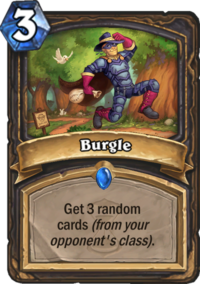
While the team has since remedied this design issue, their original intention for the mechanic revolved around collecting cards from your opponent’s class, and then giving you benefits on the basis of having them. You might get mana discounts on the stolen cards or have cards that benefit from playing or having cards from other classes.
Flavor-wise, this is fine. Rogue’s steals stuff, and this is kind of like stealing (even if Priest’s cards are more directly comparable to theft). Balance-wise, it’s pretty fine as well. It can be used as a means of balancing “drawing” a card, because the cards you get aren’t always guaranteed to be good. Swashburglar can be a balanced card, where a 1 mana 1/1 that just drew a card from your deck is less so.
However, the major stumbling block of this entire mechanic was glaring: it didn’t work in the Rogue mirror. Any card that benefits from having cards from an opponent’s class wouldn’t activate if you were burgling cards from your own class. When your mechanic’s synergy falls apart if you match against a specific class, this feels awful. This is something that should have been apparent before anyone even play-tested any of the cards, and the fact that it got shipped after being tested is particularly weird.
Now the new version of the mechanic works much better – as it steals from a non-Rogue class – but it certainly loses flavor. If I’m playing against a Rogue and I burgle a Warrior card, it’s doesn’t have the same feel.
Baku/Genn (Odd/Even)
“Start of game: If you deck contains only even/odd cost cards, change your hero power”
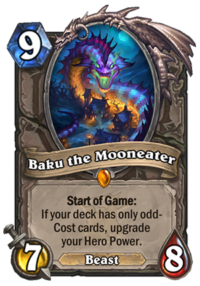
While Baku was the greater offender in this regard – as upgraded hero powers generated more polarizing game play than cheaper ones – both decks shared the following issue in common: they reduced a lot of game play to pushing a button almost every turn.
Hero powers are great for the game. They help define classes and give you things to do if you don’t have cards to play. Baku the Mooneater and Genn Greymane took this concept way too far, however, encouraging people to click their buttons instead of playing cards. Fighting against a button that can be clicked every turn is less interesting than fighting against cards. Buttons are simply more predictable (you can always push the button and it always does the same thing), and if your deck happens to not line up well against the button, so much the worse for you; you’ll just fall further behind each turn that button gets pushed, which is almost every turn.
Moreover, because this was an effect that always triggered at the start of the game for free, the decks could never fail to operate. The previous iteration of this kind of effect – Justicar Trueheart – had to be first be drawn, and then 6 mana had to be spent to play her, leaving the player potentially vulnerable. This was much better design, as it was a card and added some variety to games.
Baku and Genn’s mistake was ultimately remedied in Standard by their premature rotation to Wild via the Hall of Fame. While the play experience they offer in Wild isn’t really better, the entire format is much more degenerate, so fewer people notice.
Patches the Pirate
“After you play a pirate, summon this minion from your deck”
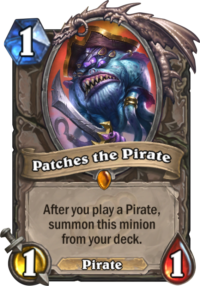
Many players have failed to understand why Patches the Pirate is a strong card. To fully appreciate why it’s good, you need to translate its card text a bit to reflect it’ text in practice: “0 mana 1/1. Pirate. Battlecry, draw a card. Almost always starts in your opening hand.” With that bit of translation, we can see what made Patches so outrageously powerful and meta defining: it’s a card that doesn’t cost a card. Literally a free resource.
It used to have Charge as well. This created immediate impact which was sometimes compounded by cards like Prince Keleseth (we’ll get to that in a minute), Southsea Captain, board buffs, and minions that benefit from having stuff in play, like Sea Giant and Corridor Creeper. Sometimes players were getting an extra 0 mana card that just happened to be a 3/3 with charge that reduced the cost of a Corridor Creeper in hand. In Wild, the card is still a format-defining staple, and can be combined with other synergies like Ship's Cannon.
Patches was poorly designed from the perspective of power alone. However, making matters even worse is what happens when his effect fails. Because Patches is so strong when you don’t draw it, drawing it feels terrible. Patches is caught in that awful world where the card was so powerful it nearly required you play it, but also punished you for playing it at the same time. When the punishment of a card is, “you drew it,” something is wrong.
When anti-pirate tech cards like Golakka Crawler were created to help deal with the problem Patches created, this punishment issue felt even worse. Playing Patches in your deck was still the correct plan because of how good it was. Sometimes you got punished because you drew it and it felt awful. Other times you got punished because of the crab and that felt awful too. Despite that awfulness, you still played it if you wanted your deck to be as good as it could be. You just pushed through the punishment.
Untapped Potential
“Have some unspent mana for 4 turns. Reward: Your choose-one cards choose both”
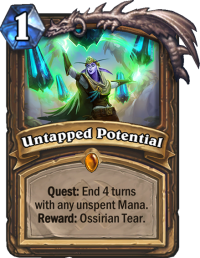
It’s hard to know where to start on this card. Unlike every other Quest in the game, this is one that can be completed by every class in the game without difficulty. It’s so easy to complete, in fact, that someone who isn’t even playing the game can complete it. In terms of its flavor, it’s less of a Quest and more of a timer. Baku and Genn were issues because of their consistency, and so is this. You have to try to not complete it and even then you might not be able to fail. Imagine any other Quest having that completion condition and immediate/constant activation and you’ll immediately see why it’s an issue.
When completed, not only does it break the power level of every single choose-one card in the game, but it also removes what is interesting about choose-one cards in the first place. The entire purpose of the choose-one mechanic is that it provides flexibility at the expense of power. With the Quest completed, every card just offers raw power. Not only does that make the cards less interesting (“Which mode is this best played in?” isn’t a question anyone need ask again), but it heavily constrains what choose-one cards can even be made. It’s much harder to imagine a choose-one card that is playable on its own but not desirable in the Quest deck than it is to just imagine fun and interesting choose-one cards that might be made in the absence of the Quest.
Further, because the Quest is always active – you don’t need to pay mana to get the ability, like every other Quest reward – it doesn’t even create any nested choices, such as, “Do I spend 2 mana to get both effects on the card or play it in a single mode because I need to use the rest of my mana to do something else?”
It’s not a Quest; it’s a consistent timer. It takes away what is interesting about a class mechanic. It heavily constrains design space. It breaks reasonable cards and makes a class good at doing things it’s supposed to be weak at, according to the designers themselves. It’s hard to think of what makes its design positive.
Crackle/Imp-losion/Tuskarr Totemic
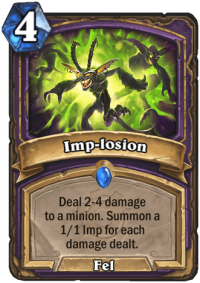
These three cards are going to get grouped together because they all have similar kinds of effects: random effects with huge ranges that occur early in the game.
In the case of Crackle, it was a 2-mana spell that dealt 3 to 6 damage to a target and overloaded you for one. Imp-losion was a 4 mana spell that dealt 2-4 damage to a target and summoned as many 1/1 imps. These spells might kill the thing you pointed them at while giving you a huge board lead… or not kill them and possibly lose you the game. Crackles for lethal vs non-lethal damage were always incredibly frustrating to one of the players. Four-plosions won games that two-plosions lost. Because that happened at such crucial stages in the game, these cards almost always led to a headache for someone. You don’t want to design cards that always feel bad.
But the Tuskarr Totemic might have been the worst offender. Originally, it was a 3-mana 3/2 that summoned a random totem on Battlecry. That could be the difference between an additional 0/2 that did nothing or a 3/4 (Totem Golem) on turns two or three. If memory serves, rolling Mana Tide Totem off it tended to be even better, on average. The range of possible game-breaking results was maddening, and eventually resulted in a nerf to only summoning basic totems, making the card bad.
While there’s something to be said about Hearthstone being a bit of random, wacky fun, these were neither wacky or fun. They were just random and upsetting. There have been other random offenders (like Yogg-Saron, Hope's End), but at least they tend to wait for later turns to be good.
The Entire Highlander Mechanic (and Keleseth)
“If you draw your good card, win the game”
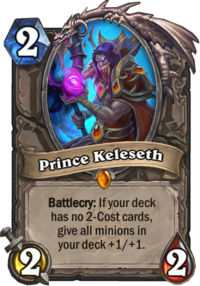
All these cards are going to be grouped together, as they all require something similar of the player and have similar outcomes. These are cards that require players have decks handicapped in some way (either without duplicates or without other 2-cost cards), and the payoff for making your entire deck worse is that you get some number of cards that are so far beyond the usual power curve they make up for that fact.
To restate that: these effects are so good when drawn that they’re worth making an entire deck worse.
In essence, these cards represent frustrating design because they massively increase the impact of draw randomness. If you got your Zephrys the Great, or Reno Jackson, or Dragonqueen Alexstrasza, or other Reno (Reno the Relicologist), or Prince Keleseth, or Kazakus, or whichever card we’re talking about, your win rate goes way, way up. If you don’t draw those cards, your entire deck is worse. They simply polarize the game play experience in ways that neither player has any control over.
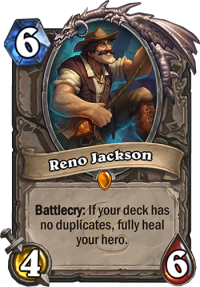
But they do worse than that on a larger scale. Because Highlander decks only play single copies of cards, it is usually correct for the opponent to not play around specific answers. After all, it’s unlikely those answers are in hand. When they are, however, they feel much more punishing. In an example, it feels worse when the opponent has the Frost Nova they need to win the game if they only play one copy, as opposed to if they had two. When they only have one copy we, as players, can say to ourselves, “The odds they had it were so low,” much more often, making people feel cheated.
Now if these cards were designed to help that specific archetype of deck exist, they’d be at least a little better; if the said, “If your deck began with no duplicate cards”. One major issue with the highlander cards, however, is that their design doesn’t even force a Highlander archetype. Certain decks that simply draw a lot have opted to play them from time to time. While some may argue that this creates a new dimension to the cards, one of those dimensions is that they randomly get generated sometimes and win games.
Finally, these cards are only interesting to the extent they are rare. When it was only Reno Jackson in League of Explorers, Reno decks were wacky and more interesting to face. Then came Kazakus, which pushed them into major meta forces. Then more recently in the new League cards, plus Zephyrs and Dragonqueen. Now, in Wild, there are decks where 1 out of every 6 cards or so has a payoff for only having singletons. The more this keeps up, the less the design is a punishment and the more it’s a reward, negating the original design intent.
Honorable Mentions
While this list doesn’t cover all the poorly-designed cards in the game’s history, I think it covers most of the major offenders. There are some honorable mentions, including Jade Idol (infinite, monstrous resources that spawned a unique tech card – Skulking Geist – that accidentally hit other decks too), Luna's Pocket Galaxy (a card whose effect is one you never even want to be playable), Hero Cards in general (which often define entire win conditions that cannot be interacted with), Time Out! (extreme non-interaction), and many others. I just think they don’t offend to the same degree as those listed above.
Let us know what you think: which card designs offend you and why?

No mention of Inspire (weakest thus far) and Discover (the one that turned the game into the senseless, controll mauling, RNGfiesta of today along with “Add random something”)?
Seems legit.
Patches the Pirate is one of the most well designed and healthy cards of the history of the game.
Back in the day when Hearthstone was actually fun.
I love jalexander, i hope see more articles from him in the future! (Not that the rest aren’t great, i just have my fav)
I’m surprised that Mechacthun didnt make the list. or the warlock skull either. it sucks when you play against a guy who is gonna win cause he drew all the cards in his deck first. absolutely terrible mechanic.
I disagree in puting Kaleseth and Higlander mechanic in same box. Higlander decks create RNG but makes games less repetitive too. As you said, too many consistency is super boring because every game feel the same. Rng is good for that
I think Keleseth is similar kind of RNG — if they don’t draw him, they don’t have any good 2-drops, but if they draw him early, it’s basically game over
Highlander decks are pretty meh as a mechanic IMO (though they irritate my inner Flik Skyshiv) but Zephrys… Zephrys can f*** right off. In casual matches I’ll generally concede now before the opponent even gets a chance to pick – I detest Zephrys.
Despite the fact that I probably Rogue main, I actually dislike the entire burgle/steal mechanic. It’s bad enough that I’ve landed in a frustrating/tedious game vs Priest (there are no other kinds of game vs Priest) but to have them essentially kill me with my own deck just adds insult to injury.
So, yeah, currently I’m giving out free wins – all you need do is roll up playing Priest or Highlander Mage and I’ll concede.
What comes to the original burgle. Instead of making burgling target to be another class that your own it could have been changed so that any burgled card would have been target for synergy cards. Like mage has his own mechanism for cards that did not start on own deck.
Just make it read “stolen/burgled” instead of “another class” and define well what stolen/burgled means. Like dunno there is not many pigholes to burgle if you define it well enough. This way mirror matches would be fine and flavor would have been intact.
Can something be said about rush as a keyword? Charge usually comes with heavy downside and isn’t intended as removal (I know, leeeeeroy). But rush cards are essentially removal spells with the upside that they work on an empty board. For years, spells were usually reactive whilst minions were usually proactive. Why change that?
Flanking strike? No problem. Restless mummy? Make a spell that reads “deal 3 damage to enemy minions, twice”.
Another few more points to be made about highlander:
When building these decks, people often just throw together many of HS’s op cards and make it work. Legendaries are one of anyways, so why not? For example, siamet and zilliax are often added even if they don’t synergize with any other cards in the deck. A deck shouldn’t need “fillers”.
It’s also more complicated to play to your own outs. i.e. if you have two swipes in your deck, the right play may be spreading plague into branching paths for double attack when fighting against quest rouge’s 4/4s. (Yes, this is a reference).
Perhaps one exception can be highlander secret hunter, because it already requires 20+ unique core cards and many of its cards have anti-synergy as duplicates.
Mage is also not so bad, since her class identity is RNG fiesta, so why not make it more so :p.
Anything that causes a card’s mana cost drop to 0, like Sorceror’s Apprentice, or the card’s own text, like the giants. Many combos that feel unfun to lose to are a result of making cards that don’t start at 0 become 0. I’d like to see the general rule become nothing drops below 1; if it isn’t printed to be 0 cost in the first place, it can’t become 0 cost by any other means.
I would add resurrect mechanism into list. It also can create quite “infinite” value. What I generally hate most is situation where the game is possible to win but odds are thin and game will probably be long.
resurrect was good in theory but when they created so many ways to cheat out powerful monsters for priest it became a problem
I’d disagree with both sides. This article is about poor mechanical designs, not broken mechanics. Having an entire deck built around repeatedly generating specific minions is a unique design that makes sense. Cheating out undercosted minions is actually found in nearly every class. Also, barnes is neutral.
The cost of these “cheating” cards may need adjustment to make them not too op, but that doesn’t mean there is a flaw in design.
Caverns Below I find to be a good example, just for how inconsistent what it actually does has been, because say in mtg, if I was good enough at the rules, which I can always go read, I’d always know how any number of cards would interact, with caverns its been a Rollercoaster between patches. Can they be silenced? Can they be buffed? Can they be shrunk? Who knows?
At the risk of sounding too much like a LoR fanboy: Legends of Runeterra has an interesting take on the highlander mechanic, Purrsuit of Perfection. It’s a spell that’s basically “If you’ve played X unique cards, summon a 30/30 killer kitty mech”. So you’re able to double/triple up on any cards you want, but it will hinder your primary win condition a fraction. Plus the payoff happens at the end of the match, so it doesn’t _feel_ as game-defining as Kel / Zephy / etc. I’ve had games where I didn’t even realize my opponent was using a Purrsuit deck until he finally played it.
Speaking as a fellow LoR fanboy, I’m actually not a huge fan of how Purrsuit is designed —it’s like a Quest, but your opponent can’t see your level-up progress, or even that you have the quest in your deck. Which would make it feel pretty bad when you drop a 30/30 overwhelm out of nowhere, often winning the game instantly.
Then again, it might be a needed payoff, since every time I’ve tried it my opponent kills me four turns before I can summon Garfield. It’s also a decent tip-off that you’re running a bunch of random one-ofs in your deck.
I agree that the specific implementation could use some tuning–I would like it to be unique spells instead of cards, have the count lowered accordingly, and I wouldn’t mind if both players could see progress somehow. But with regards to the overall mechanic (game-winning reward contingent on playing X cards) and contrasting it to HS’s highlanders (big reward contingent on decklist conforming exactly), I think it’s miles better.
Shudderwock and Corrupt the Waters deserve a mention as well, for reasons very similar to Untapped Potential. Weak and (frankly) uninspired Battlecry minions such as Nithogg can be attributed directly to the perpetual fear of making something that would become broken when duplicated.
(People mostly focused their wrath on Corrupt Elementalist and Mogu, but Shudderwock’s duplication of the Galakrond battlecry played no small part in the deck being as oppressive as it was).
I actually like Nithogg as a card, it’s just that this specific implementation (in terms of mana cost & stats) is pretty weak compared to the rest of the meta.
Untapped potential
Quest: Do nothing.
Reward: All your cards are twice as strong for the rest of the game.
I’m surprised the original warsong commander didn’t make the list.
Who hurt you?
I agree with most of them. Ice Block (non-interaction) and Bloodbloom (mana-cheating) are also good examples of badly design cards.
I like Highlander decks though, because of the singleton restriction you’re not always playing the same cards but some of the payoff cards are too strong.
I also like Highlander decks – many of my favorite decks in the history were Highlander (like Renolock or Razakus Priest). And I admit that it’s not the best design due to increased impact of draw RNG. The thing is, though, that something can be a bad design and you can still enjoy it 🙂